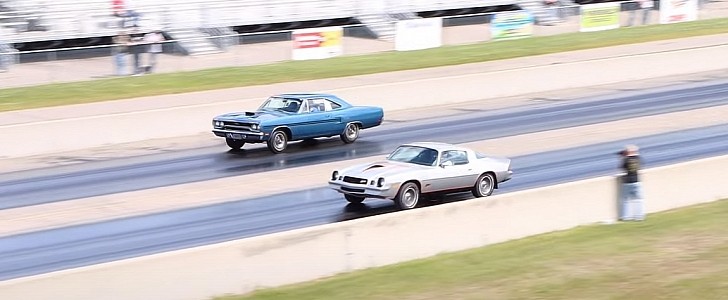The muscle car scene changed dramatically over just a couple of years in the early 1970s. The oil crisis and then-new emission regulations saw American high-performance cars lose much of their grunt to become mundane vehicles toward the half of the decade. Once a glorious pony with more than 400 horsepower, the Chevrolet Camaro barely made 200 horses by 1975, and that applied to all muscle cars of the era.
The horsepower drop was actually a bit smaller than it seemed, mostly because automakers had also moved from gross to net ratings starting 1972. But the gap was there, and the cars became notably slower. To put things into perspective, late 1970s pony cars were usually around three seconds slower at the drag strip than their early 1970s counterparts.
But not all drag races between muscle cars almost ten years apart will return similar results. This duel between a 1970 Plymouth GTX and a 1978 Chevrolet Camaro Z28, which took place in the Factory Stock class, ended with a rather shocking result.
We all know very well that the Plymouth GTX is one of the finest muscle cars of the early 1970s. Available with a massive 7.2-liter V8, the GTX came with a whopping 375 horsepower and 480 pound-feet (650 Nm) of torque (both gross figures) in 1970. The 1978 Camaro Z8, on the other hand, has only 185 horses and 280 pound-feet (379 Nm) of twist (both net) at its disposal from a small-block, 5.7-liter V8.
But some other things set these muscle cars apart. For starters, the Camaro comes with an automatic transmission, while the GTX is fitted with a rare four-speed manual (only 1,471 built in 1970). The Plymouth is also loaded with all sorts of convenience features, so it's more than 200 pounds (90 kg) heavier than the Camaro.
Is this enough to level the playing field? Well, based on power and torque ratings alone, the GTX should win such a drag race easily. But the result of this battle is the exact opposite. The Camaro goes on to win all three races, hitting its fastest ET at 13.92 seconds. That's three seconds quicker than its official quarter-mile rating from 1978.
The GTX runs consistent 14-second sprints with the fastest at 14.18 clicks, but it's not enough to defeat the Camaro Z28. So what happened here? Is there something wrong with this GTX? Is the driver unable to drive stick? It sure doesn't seem like it (even though the Plymouth could be faster with better shifting).
The answer lies in the regulations of the F.A.S.T. class. Even though it's called "Factory Stock," this classic drag racing category allows certain drivetrain, rear axle, and exhaust system changes. So we're most likely looking at a 1978 Camaro Z28 with an amazing tune-up that's still within regulations.
Just to get an idea of how permissive it is, the class allows shift improving kits, any rear-axle gear ratio, overbores of up to 0.070", increased compression ratio, and jetting and metering changes to the carburetor. It sounds like enough freedom to shave significant time off a factory-advertised quarter-mile sprint.
But not all drag races between muscle cars almost ten years apart will return similar results. This duel between a 1970 Plymouth GTX and a 1978 Chevrolet Camaro Z28, which took place in the Factory Stock class, ended with a rather shocking result.
We all know very well that the Plymouth GTX is one of the finest muscle cars of the early 1970s. Available with a massive 7.2-liter V8, the GTX came with a whopping 375 horsepower and 480 pound-feet (650 Nm) of torque (both gross figures) in 1970. The 1978 Camaro Z8, on the other hand, has only 185 horses and 280 pound-feet (379 Nm) of twist (both net) at its disposal from a small-block, 5.7-liter V8.
But some other things set these muscle cars apart. For starters, the Camaro comes with an automatic transmission, while the GTX is fitted with a rare four-speed manual (only 1,471 built in 1970). The Plymouth is also loaded with all sorts of convenience features, so it's more than 200 pounds (90 kg) heavier than the Camaro.
Is this enough to level the playing field? Well, based on power and torque ratings alone, the GTX should win such a drag race easily. But the result of this battle is the exact opposite. The Camaro goes on to win all three races, hitting its fastest ET at 13.92 seconds. That's three seconds quicker than its official quarter-mile rating from 1978.
The GTX runs consistent 14-second sprints with the fastest at 14.18 clicks, but it's not enough to defeat the Camaro Z28. So what happened here? Is there something wrong with this GTX? Is the driver unable to drive stick? It sure doesn't seem like it (even though the Plymouth could be faster with better shifting).
The answer lies in the regulations of the F.A.S.T. class. Even though it's called "Factory Stock," this classic drag racing category allows certain drivetrain, rear axle, and exhaust system changes. So we're most likely looking at a 1978 Camaro Z28 with an amazing tune-up that's still within regulations.
Just to get an idea of how permissive it is, the class allows shift improving kits, any rear-axle gear ratio, overbores of up to 0.070", increased compression ratio, and jetting and metering changes to the carburetor. It sounds like enough freedom to shave significant time off a factory-advertised quarter-mile sprint.







